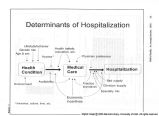| OCR Text |
Show in order to be overcome. As this article indicates, homeless people present with difficult to manage, complex, and expensive medical problems. Most middle-class medical practices, while able to provide services for a small Medicaid population, have no experience in providing services to the remaining, harder-to-serve segment of our poverty population and have no intention of gaining such expertise. For those homeless patients who experience episodes of mental illness, there is a grim outlook for the future. Before the onset of de-institutionalization, many chronically mentally ill individuals on the streets of Salt Lake, Ogden, or Provo might have been admitted to and remained in state hospitals for life, where their mental and health care needs would have been relatively simple "because virtually all services for chronic patients were delivered within a single physical setting and under a single authority" (Bachrach, 1982: 190). Summary Among the solutions to the pressing needs outlined above are more low-cost housing, and more funding for rehabilitating available housing. Further, we need to assure that all homeless people will be provided medical care for their health needs regardless of their age, sex or work status. Finally, we need to regain our humanity towards our fellow human beings by getting through the obstacle of "blaming the victim." Guilty or not, it is more cost-effective to provide prevention than to ignore health problems. As we move into the unprecedented arena of managed health care, insufficient attention for too long has been paid to the manner in which our poorest citizens will gain access to health care in a managed care environment. There is no doubt that one of the most ominous scenarios for addressing this issue will be an attempt to pass responsibility for footing the bill for caring for homeless and so-called "indigent" people down from the federal level to state and local governments. For a variety of reasons, state and local governments will be reluctant to accept the ultimate responsibility, the burden, or the cost of taking up the slack for provision of health care to this segment of the American population. Yet, in some regards, we as a state are encouraging such a change in scope. Any examination of the evolving role of health care and its management in the state of Utah must begin with an acknowledgment of the growing role of the fiscal and moral conservative philosophy held by a politically influential segment of the population of the United States and Utah, and the resulting shrinkage of the reserve of health care dollars set aside for the poorest of the poor. Utah is playing a significant role in the area of defining of state's rights, a position in which our present governor, Michael Leavitt, has been a national leader. The task of assuming the management of health care for such a large population is certainly too large for the private sector to write off as charity or to manage with free volunteer clinics which sometimes function as "band-aid" medicine. Further, there is a responsibility for all care providers to ensure that a lesser level, or "second tier" of health not be continued. The task of planning for provision of health care delivery to poverty-level people must incorporate a partnership of federal, state, local, and private providers who are "specialists" in delivering services to such an at-risk culturally diverse population, and who are otherwise in accord with a long-term plan that incorporates the issues raised above. We need more, not less, funding for substance abuse treatment, and housing to accommodate new substance abuse programs. We need to address again the issues of isolation for active cases of tuberculosis. We need to look critically at how long to hospitalize homeless patients who have no homes to return to for further recuperation. We need housing for women with newborn infants to keep them from returning to shelters where contagious diseases, including influenza, shigella, diarrhea, and measles are more likely to occur. It is time we looked critically at that cracked mirror image of our society and begin to make the necessary repairs. The concept that providing managed care to homeless people will cost less is unrealistic. The phenomenon of increasing access to high-risk vulnerable people will cost more up front but will have a larger payoff later. It is the long-term payoff that our state must commit to and partner with managed care organizations being willing to assume the community responsive role. The fear is that for-profit organizations will be unwilling to play this role. Inevitably, the state must recognize that the cost for individual treatment must have a higher capitation rate than that allocated to the at-large population. Finally, we must remember that we are only as large as the smallest among us as a society, and keep the human side of health care firmly intact while addressing the issue. Utah's Health: An Annual Review 1995 21 |


























































































































































